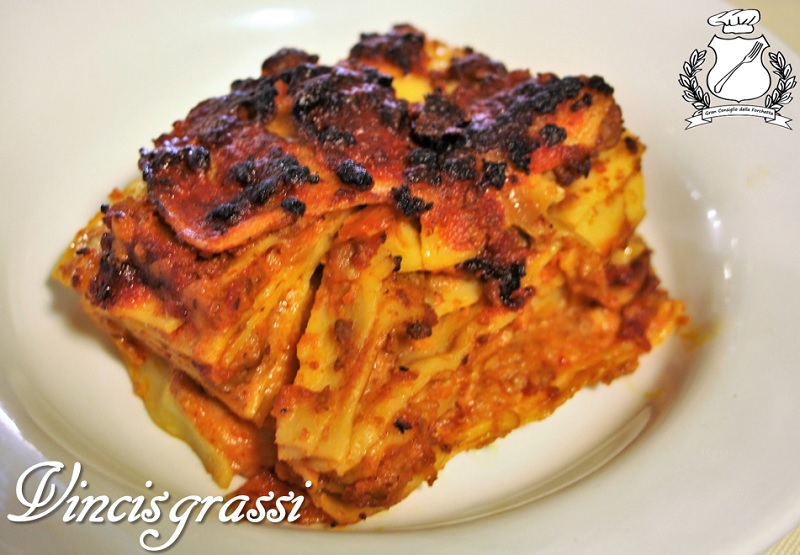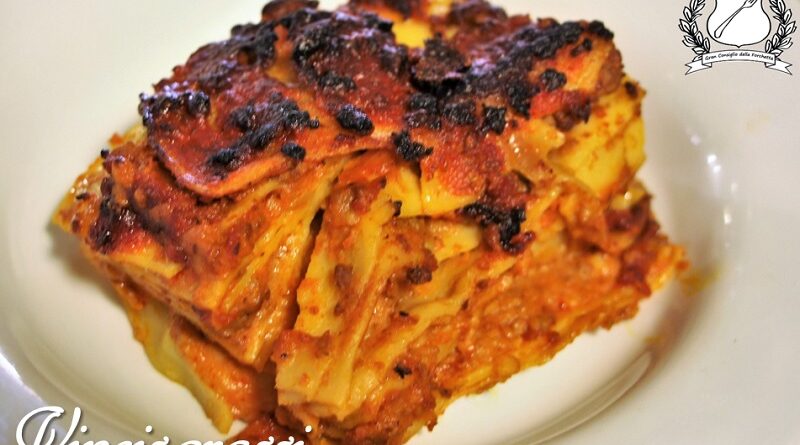Vincisgrassi

Vincisgrassi
Duration: 3 h e 30 min
Difficulty: Challenging
Regione: Marche
Very often, they are confused with lasagna, but Vincisgrassi is one of the most traditional dishes of the Marche region. And in reality, although they look similar, they differ in various respects, including origins. Many date them back to the siege of Ancona in 1799, when the Austro-Russian-Turkish troops opposed Napoleon’s troops, besieged in the city. According to tradition, it was a cook from Ancona who presented this dish to the Austrian general Alfred von Windisch-Graetz, winner of the siege and from whom the name of this dish was derived Vincisgrassi, a simple Italianization of his surname.
But there are other testimonies, they would make it go back to previous eras, with the name of princisgrass, although in reality, although similar, this dish involved the use of truffles, while the béchamel sauce and chicken giblets were completely absent.
Wine pairing: Rosso Conero DOC
Ingredients
For a tray for 8 people
For the pastry:
- 800 g of 00 flour
- 8 eggs
- salt
For the gravy:
- 500 g of beef and pork stew
- 500 gr of mixed veal bones
- 2 chicken legs
- 1 carrot
- 1 stalk of Celery
- 100 g of chicken giblets
- 50 g of pork lard
- 2 cloves
- 500 g of Peeled Tomatoes
- ½ tube of tomato preserve
- 1 glass of white wine
- Extra virgin olive oil
- Pepper
- salt
How to Proceed
On a pastry board, pour the flour forming a fountain, break the eggs inside and add a little salt. Mix everything until you get a compact and homogeneous dough. Form a ball, cover it with transparent film and let it rest for half an hour.
After this period of time, roll out a fairly thin sheet. Then cut it into large rectangles, which will form the various layers of the vincisgrassi.
Now let’s think about preparing the sauce. Chop the lard, then chop the carrot, celery and onion. Pour the mince and the lard into an earthenware pan (if you have one, otherwise a saucepan is fine) and add a drizzle of extra virgin olive oil. Fry until golden brown then add the stew, bones, chicken legs and giblets. Brown everything well, turning the contents with a wooden spoon. When everything is well browned, blend everything with the white wine and leave the heat high so that it all evaporates. Once the wine is dry, the time has come to add the peeled tomatoes and preserves. Only at this time will you add the salt and cover everything with hot water.
Lower the heat and let everything cook for at least 2 hours. Once the time has elapsed, remove the meat from the sauce and cut it into many very small pieces, then put it back in the sauce. Do the same with the chicken thighs, while discarding the bones. Continue cooking for another hour. Add the cloves towards the end (if you like them).
Boil salted water in another saucepan while put cold salted water in a bowl. Boil the rectangles of cut pasta in boiling water for a few minutes, then pour them into cold water and then dry them by placing them on a cloth.
We have finally reached the final moment. We take a nice rectangular pan and cover the bottom with the sauce, then add a layer of boiled pasta. Make the dough adhere well to the pan, covering it without leaving empty spaces. Then add a layer of Parmesan. Repeat the same operation 6-8 times (depending on the depth of the pan). Then cover the last layer with the ragu. Finally add a final sprinkling of Parmesan.
Put the pan in the oven at 200°C and let the vincisgrassi cook for about an hour. The top layer will form a beautiful crispy crust.

